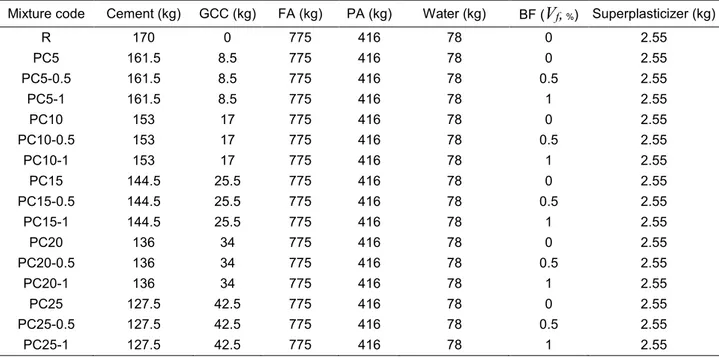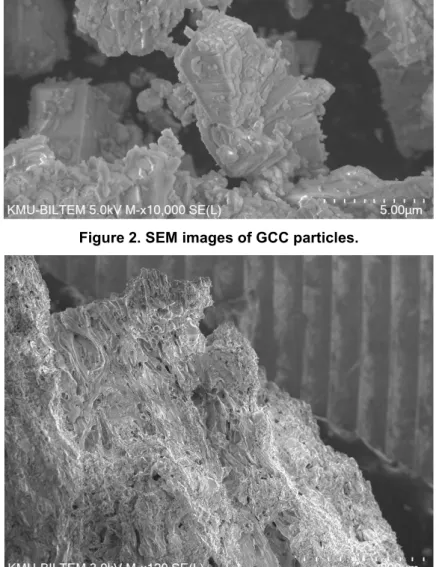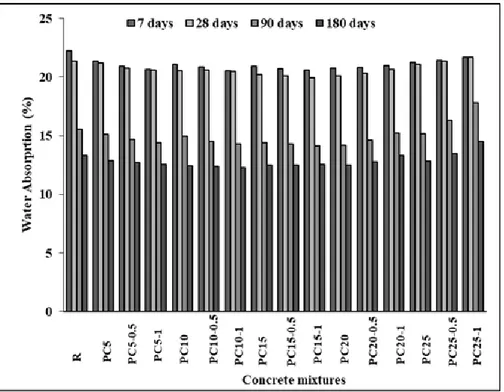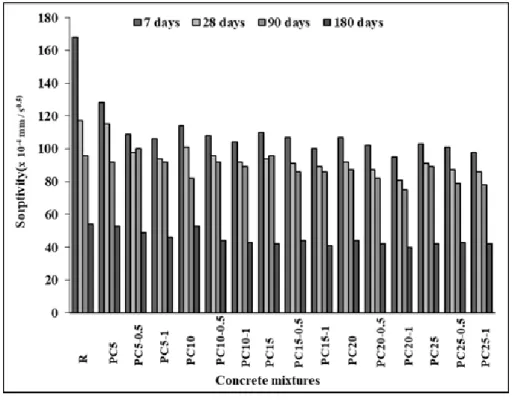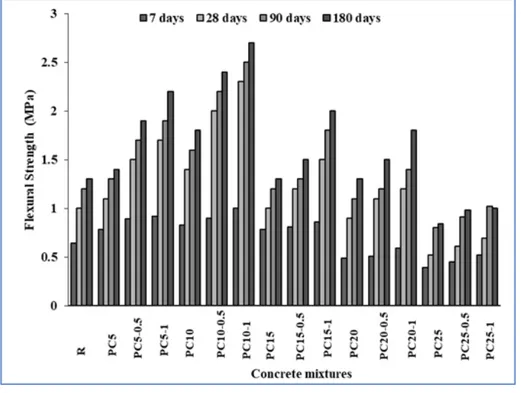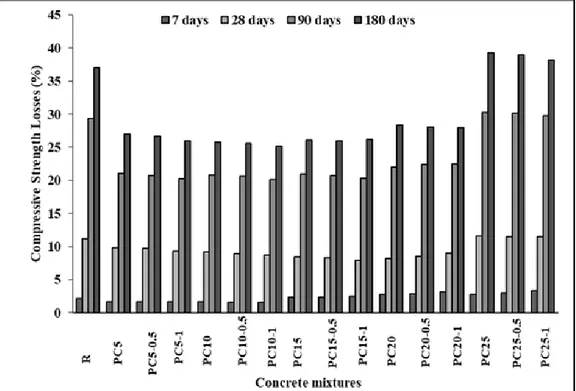Karaburc, S.N., Yildizel, S.A., Calis, G.C. Evaluation of the basalt fiber reinforced pumice lightweight concrete. Magazine of Civil Engineering. 2020. 94(2). Pp. 81–92. DOI: 10.18720/MCE.94.7
This work is licensed under a CC BY-NC 4.0
ISSN
2071
–0305
Magazine of Civil Engineering
journal homepage: http://engstroy.spbstu.ru/ DOI: 10.18720/MCE.94.7
Evaluation of the basalt fiber reinforced pumice lightweight concrete
S.N. Karaburc, S.A. Yildizel, G.C. Calis*
Karamanoglu Mehmetbey University, Karaman, Turkey * E-mail: gokhancalis@kmu.edu.tr
Keywords: lightweight concrete, ground calcium carbonate, basalt fiber, cement
Abstract. This paper aimed to investigate the mechanical and durability properties of basalt fiber reinforced pumice lightweight concrete (BPLC) containing nano ground calcium carbonate (GCC). GCC was utilized as ordinary Portland cement replacement material at the percentages of 5 %, 10 %, 15 %, 20 % and 25 %, and basalt fibers with the 6 mm length were added in two contents of 0.5 % and 1 % by volume. The experimental results showed that GCC added mixes had lower mechanical strength results at the early ages; however, comparable strengths with the reference mixes at later ages. The addition of GCC addition also resulted in decreased water absorption, sorptivity and increased magnesium sulphate resistance compared to the reference lightweight concrete. Basalt fiber utilization enhanced the mechanical properties of the BPLC, but fiber inclusion lessened the fresh concrete properties. With respect to the enhanced material properties and less cement usage with produced BPLCs, it can be suitable for the green concrete block production industry.
1. Introduction
Lightweight concrete has been widely used in several parts of the construction industry such as masonry concrete block and wall panel productions due to its low density and thermal conductivity, and high strength to density ratio [1]. However, some disadvantageous properties have been also reported such as brittleness, lower mechanical strength and crack forming at early ages [2]. The application of lightweight concrete reduces the structural loads and the cost of the structural elements production. For this reason, it is widely preferred for the structures constructed in seismic zones [3, 4]. Portland cement containing lightweight concrete are traditionally produced with lightweight aggregates such as diatomite, perlite, pumice (from natural sources), and recycled clay bricks (recycled sources) in many researches [5–7]. Construction industry requires new developments due to increased needs, therefore fiber additions [8, 9], nano additives [10] have become significant solution to these increased needs.
The reinforcing fiber inclusion to the lightweight concrete mixes has been reported in many experimental studies. Fiber is used in order to enhance the fresh and hardened state behaviour of the concrete. Many types of the lightweight concrete have been developed to investigate the behavior differences that can be attributed to the fiber types (steel, carbon, etc.) and their lengths [11, 12].
Due to the environmental reasons, the demand for the cement replacement material to formulate environment friendly and economical concrete is rapidly growing. Therefore, many researches have been focused on cement replacement materials and alternative binding materials [13, 14]. Utilizing cement replacement materials such as GCC may enhance the strength and the cohesiveness of the concrete mixes or mortars. Nano GCC is widely used for filling the structural gaps in the microstructures and providing bleeding and shrinkage mechanism control [15].
The tensile strength property of the concrete mixes can be significantly improved with the inclusion of fibers. The cost of the fibers can be reduced by adding cheaper synthetic fibers compared to the metal fibers [16]. Basalt fibers are one of the environments friendly and high-performance fibers, and it has been widely utilized in many researches [17, 18]. These types of fibers can improve the flexural strength and toughness properties of the cement based composite materials [19]. Basalt fiber is also preferred due to its positive impact on corrosion resistance, high tensile strength [20]
As it is widely known compressive and flexural strength of concrete is vitally important. Furthermore, sorptivity, dry bulk density, water absorption, setting times and sump test results are also included. In terms of containing two materials namely fiber and grand calcium, this study is unique.
It is reported by many researcher that fiber addition, especially steel, carbon and polypropylene fibers inclusion to the lightweight concrete mixes improved the material properties such as modulus of elasticity, abrasion resistance, freeze-thaw resistance, drying shrinkage and porosity [21, 22]. Among all fiber types, carbon fiber are commonly utilized due to its superior contribution to the composite materials such as high strength, good stability and good bonding behavior with the cement; however, its high cost limits the application of carbon fiber reinforced concrete [23]. Basalt fiber is also used as an eco-friendly and high-performance fiber in the research of fiber reinforced concrete materials. Basalt fibers can enhance the both compressive and flexural strengths, and toughness together with the fracture energy in the cement matrix composite applications [24]. Basalt fibers are also have a better binding performance with the cement due to its similar chemical properties with cement, and it is cheaper compared to the other widely used fibers in civil engineering researches [25]. Basalt fibers have many times greater tensile strength than steel fibers, and it has been widely used as small pieces during the mix design of concrete composites in civil engineering applications [26]. Steel and polypropylene fibers addition to the lightweight concrete mixes has been widely researched, and different results reported due to the variety of the examined parameters. In most cases, positive influences [27–29] have been reported for the strength improvement of the cementitious composites. However, very limited literature exists for the basalt fibers on the lightweight concrete composite production. The researches into basalt fiber added conventional concrete were generally focused on the mechanical properties of the composites. Those research results indicate that basalt fibers addition up to 0.5 % by volume was beneficial, and optimum fiber dosage can vary significantly according to the types of the concretes [17, 30, 31]. Primary benefit of basalt fiber addition can be evaluated as a shift from a brittle failure behavior to more ductile one for conventional concrete mixes under compressive loads [31]. And literature suggest that basalt fiber addition can significantly increase the tensile strength of concrete [32]. Basalt fiber inclusion has also been shown to increase toughness of the concrete; however, it is difficult to assess the relative benefits since different test methods were applied [33].
Portland cement is one of the fundamental components of the mortar, grout and concrete production. Approximately, 5.78 GJ of thermal and 138 kWh of electricity energies are consumed intensively during the production of one ton of Portland cement [34]. Cement production is also responsible for the release of significant amount of CO2 emissions. It was estimated by International Energy Agency (IEA) that CO2
emissions during the cement production could be reduced by 18 % compared to the current levels by 2050 [35]. There are many ways to reduce the carbon footprint of the cement production such as carbon capture and storage, improving thermal and electric efficiency, clinker substitution and reducing usage of cement amount in construction industry. By product materials such as silica fume, fly ash and slags are daily used in the production of concrete as cement replacement materials [36]. In addition, many researches have been conducted focusing on the potential usage of minerals as cement supplementary materials [37–40]. GCC have typical particle size comparable to Portland cement. Nano GCC is generally utilized as mineral filler in concrete mixes [41]. Increased early strengths were obtained in many studies by replacing cement with the nano GCC, however, high dosage GCC inclusion as cement supplementary material in concrete can be resulted in reduced strength [15, 42]. The reactivity of the nano GCC depends on its surface area, andmsmaller particles provide more surface are for the reaction with the C3A [43]. GCC has small grinding
energy consumption compared to the other supplementary materials due to its low hardness [44].
Available experimental results from the literature review revealed that the use of basalt fiber in pumice lightweight concrete containing nano GCC cannot be considered as sufficient. Reported research results reflect many dissimilarities due to variety of examined parameters. This study aims to discover mechanical and durability properties of basalt fiber reinforced pumice lightweight concrete containing nano ground calcium carbonate. Compressive and flexural strength tests were carried out within the scope of the study. This study also aims to enrich available experimental data in the literature on the pumice lightweight concrete production in order to reach a better understanding of its behavior.
2. Methods
2.1. Materials and Mixture Design
The materials used in this study are Fine Aggregates (FA), Pumice Aggregates (PA), Basalt Fibers (BF), commercially available nano GCC (Betocarb® F) and CEM I 42.5 R Cement. Particle size distribution of and physical properties of the blended aggregates are given in Figure 1 and Table 1, respectively.
BFs with the length of 6 mm were used in the experimental study. The technical properties of the BF are summarized in Table 2. Polycarboxylic based hyper plasticizer was utilized in all mixtures at the amount of 1.25 % of cement by weight.
Figure 1. Particle size distribution of mixture and Fuller curve.
Table 1. Physical properties of the aggregates.
Aggregates Particle size (mm) Particle density (g/cm³) Los Angeles abrasion loss (%)
Fine aggregate(FA) 0–4 1.071 –
Pumice Aggregate(PA) 2–12 0.395 70.9
Table 2. Physical and chemical properties of the BF.
Technical property
Elasticity module, MPa 90
Tensile strength, MPa 4832
Melting point, C° 1452
Application temperature, C° –220/+980
Chemical composition Percentages (%)
SiO2 51.2–58.9 Al2O3 14.5–18.2 Fe2O3 5.7–9.6 MgO 3.0–5.4 FeO + Fe2O3 9.2–14.0 TiO2 0.8–2.25 Na2O + K2O 0.8–2.25 Others 0.08–0.14
Material properties of cement and Betocarb® F are presented in Table 3. It can be clearly seen from the chemical composition of the materials (Table 2 and 3) that BF and cement have similar very similar chemical properties, and this similarity can be resulted in good bonding mechanism among these materials [25].
Table 3. Material properties of cement, PA and Betocarb® F.
Chemical composition (%) &Physical property Cement PA Betocarb® F
Fe2O3 3.52 1.5 3.19 CaO 60.21 0.2 11.77 SiO2 20.19 75.84 61.14 MgO 2.32 0.4 2.43 SO3 2.61 0.5 – Al2O3 4.32 12.54 7.42 Free CaO, % 1.7 – – Loss on ignition 2.85 5.63 4.6 Specific gravity 3.12 1.05 – Specific surface (cm2/g) 3,618 – >30,000 Blue value – – <3 d50 % – – 3
Table 4 summarizes the mix design and material proportions. Mixtures were prepared with a pan mixer and its capacity is 60 L. The mixer rate was kept constant as 250 r/min in order to prevent the BF breakings. 16 lightweight concrete mixes were designed within the scope of this study. The blends were coded in line with the nano GCC addition and BF contents. “R” defines reference mix with no GCC inclusion and any BF content. Other mixes were coded as “PCx-y”, where “x” represents the changed ratio (%) of nano GCC by cement by weight, and “y” defines the BF inclusions (%) by volume of the concrete.
Table 4. Mixture proportions of lightweight concrete specimens (kg/m3).
Mixture code Cement (kg) GCC (kg) FA (kg) PA (kg) Water (kg) BF (
V
f,
%) Superplasticizer (kg)R 170 0 775 416 78 0 2.55 PC5 161.5 8.5 775 416 78 0 2.55 PC5-0.5 161.5 8.5 775 416 78 0.5 2.55 PC5-1 161.5 8.5 775 416 78 1 2.55 PC10 153 17 775 416 78 0 2.55 PC10-0.5 153 17 775 416 78 0.5 2.55 PC10-1 153 17 775 416 78 1 2.55 PC15 144.5 25.5 775 416 78 0 2.55 PC15-0.5 144.5 25.5 775 416 78 0.5 2.55 PC15-1 144.5 25.5 775 416 78 1 2.55 PC20 136 34 775 416 78 0 2.55 PC20-0.5 136 34 775 416 78 0.5 2.55 PC20-1 136 34 775 416 78 1 2.55 PC25 127.5 42.5 775 416 78 0 2.55 PC25-0.5 127.5 42.5 775 416 78 0.5 2.55 PC25-1 127.5 42.5 775 416 78 1 2.55
2.2. Sample preparation and testing
The effect of BF addition and replacing cement with nano GCC was investigated by physical, mechanical and durability laboratory tests. Spread diameters of the blends were evaluated by slump test. Slump test were repeated three times with 20 min (first test time includes mixing duration) intervals in order to determine slump losses. Setting times of the specimens were determined according to the requirements of BS EN 196-3 [45]. Physical test includes the measurements of sorptivity, bulk dry density and water absorption. And mechanical test were flexural strength test and compression tests. All physical, durability and mechanical tests were conducted at 7, 28, 90 and 180 days.
Bulk density and water absorption of the specimens were recorded according to the requirements of ASTM C 642 [46]. The disc specimens (Ø100/50) were prepared and initially oven dried at 105 °C and cooled in room temperature and their weight were recorded (
W
1). Following this process, the specimens were boiledfor 5 hours in a container and left in the container for a natural cooling process. Then boiled surface dried mass of the specimens were recorded (
W
2). Mass of the specimens after the boiling and immersion processeswere recorded as
W
3. Bulk dry density (B
dd, kg/m³) and water absorption (W
a, %) of the concrete mixes weredetermined by Equations (1) and (2), respectively:
B
dd= W
1/(W
2-
W
3);
(1)W
a= [(W
2– W
1)/ W
1] x 100.
(2)Sorptivity test was recorded according to the ASTM C 1585 [47]. Disc specimens (Ø100/50) were isolated with paraffin material as per the requirements of the standard. The mass of the specimen was measured at 7, 28, 90 and 180 days.
Compressive strength test was conducted on Ø150/300 mm cylindrical specimens according to the ASTM C 469 standard [48]. Flexural strength tests were performed on 100×100×500 mm specimens as per the requirements of EN 14651 [49]. Prismatic specimens were notched before the test procedure according to the EN 14651 standard at their mid-span width.
Lightweight concrete blocks are widely used in the animal shelters; therefore, it is of great importance to evaluate the acid effect on concrete blocks. Magnesium sulfate attack effect on concrete specimens was evaluated with compressive strength change. Two groups of specimens were prepared during the test. One group was kept curing in water, and the second group was exposed to magnesium sulfate concentration of 10 % in a separate container. Magnesium sulfate concentration was renewed every 20 days till the end of the test time (180 days). Compressive strength changes of the two groups were recorded at 7, 28, 90 and 180 days.
3. Results and Discussion
3.1. Fresh concrete properties
Slump and setting time test results are presented in Figure 4 and 5, respectively. Effects of nano GCC addition on slump tests are shown in Figure 4. Nano GCC inclusion up to 20 % by weight increased the spread diameter of the mixes. This can be attributed to the irregular shape of nano GCC particles (Figure 2).These results also show that nano GCC replacement by more than 20 % of the cement weight had very adverse effects on concrete workability, and this effect should be taken into consideration well when aiming to utilize such mixes for long term slump preservation behaviors. In addition, the negative impact of the presence of PA on the workability should not be neglected, since it has a porous microstructure (Figure 3).
Increasing the BF reduces the slump flow diameter of the produced concrete mixes as seen in Figure 4. BF utilization in concrete mixes generally result in slump decreases [50]. This situation can be explained as the extra cement paste and mixing water consumption of BFs and increase in the friction of coefficient between cement and BF during the mixing process. Slump test results were obtained in parallel with the previously conducted studies [30, 51]. Figure 4 also shows that all mixture kept their plasticity and cohesive behavior at 60 min.
BF and nano GCC addition negatively affected the setting times of the concrete mixes as shown in Figure 5. The results indicated a slower hydration process compared to the reference paste. In other words, slow hydration process means of releasing less heat during hydration reactions [52]. Therefore, BF and nano GCC added blends at specific ratios can be beneficial in mass concrete construction.
Figure 2. SEM images of GCC particles.
Figure 4. Slump test results.
Figure 5. Setting times of the concrete mixes.
3.2. Physical properties
Water absorption and bulk dry density of the concrete mixes at 7, 28, 90 and 180 days are presented in Figure 6 and 7, respectively. Figure 6 show that water absorption rate of the all pumice concrete mixes are gradually reduced at later ages. Water absorption rates of the specimens vary between 20.54 % and 22.24 % at 7 days. PC10-1 had the minimum value. Nano GCC and BF addition both lowered the water absorption ratio ay 7 days. This can be attributed to filling of void volumes by BF and GCC particles. Water absorption rates of the mixtures continued to decrease at 180 days, where PC10-1 had the lowest value as 12.28 %. It can also be noted that BF inclusion increased the water absorption rate compared to the mixtures having same nano GCC content.
Figure 6. Water absorption test results.
Dry bulk density test results of the concrete mixes are given in Figure 7. Density values are increased with the curing time and, highest dry bulk density values were obtained at 180 days. Nano GCC addition increased the dry bulk densities compared to the reference mix. BF reinforced mixes indicated slightly lower values than the only GCC added mixes on every experimental set up.
Sorptivity test results of the concretes are given in Figure 8, where it can be noted that sorptivity values decreased with the increasing curing time. Lowest value obtained at 180 days, and BF and GCC addition both decreased the sorptivity of mixes compared to the reference mix.
Figure 7. Dry bulk density test results.
In most cases, denser microstructure and lower absorption test results were obtained during the physical property tests. It can be expected positive contributions to the concrete durability according to the test results. The improvement in physical properties of the BPLC can be clarified by filling of voids by nano GCC and BFs. Nano GCC acted as inert mineral filler as stated in previously concluded researches [53, 54].
Figure 8. Sorptivity of concretes.
3.3. Mechanical properties
The average compressive strength test results are presented in Figure 9, where nano GCC addition up to 10 % and BF inclusion increased the test results compared to the reference mix. GCC addition was contributed to early strength development of the specimens. The compressive strength values of the mixes containing more than 10 % replaced cement, reduced at all ages. This can be attributed to high GCC content and the dilution effect. Adding certain amount of GCC could be reacted with aluminate phases in the cement, and this reaction can produce more ettringite which as a larger volume than other hydration products. As a result, denser concrete microstructure can be formed, and this situation leads to better strength properties.
BF reinforced specimens indicated better compressive strength performances compared to the other specimens. Especially, it was also found that BF addition of 1 % of volume showed the best compressive strength test results. Many researches highlighted that basalt finer usage up to 0.5 % by volume provides better results [55]; however, test results according to the used fiber content notably varied in terms of produced concrete types [18].
Figure 10 presents the flexural test results of the lightweight concretes. Flexural strength values increased with the increase in BF content of the concrete specimens. Mixes containing more than 10 % of replaced cement content showed lower performance than other mixes. In addition, a gradual increase with the curing time was also observed. Specimen PC10-1 showed the best flexural performance compared to the other specimens.
Figure 10. Flexural test results.
3.4. Magnesium sulfate resistance
Sulfate resistance of concrete has great importance in the concrete production focused literature studies [56]. It was also noted that magnesium sulfate attack can be resulted in the transformation of C-S-H gel to a non-cementitious M-S-H gel (Equation (3)) [57].
3 MgSO4 + 3 CaO 2SiO2 3 H2O + 8 H2O → 3 (CaSO4 2 H2O) + 3 Mg(OH)2 + 2SiO2 H2O [58]. (3)
In this research, concrete behavior against magnesium sulfate was determined by compressive strength changes of mixes at 7, 28, 90 and 180 days. Magnesium sulfate effect increased with the exposure time as seen in Figure 11. The most deleterious sulfate effect was observed on the reference mix at both ages. Contrary, GCC and BF addition to mixes (except PC25, PC25-0.5 and PC25-1 specimens) improved the behavior of concretes against sulfate solution. PC10-1 and PC5-1 specimens showed the lowest compressive strength losses compared to the other mixes as 25.24 % and 25.98 % at 180 days, respectively. This value was obtained as 37 % for the reference specimens.
The overall magnesium sulfate resistance test results indicated that the replacement of cement with certain amount of nano GCC (up to 10 %) had very significant effect on the concrete in terms of durability properties. BFs addition up to 1 % of volume also contributed to enhance the sulphate attack resistance by filing up voids in the concrete structure. More impermeable and low carbon footed BPLC specimens were produced within the scope of this study.
4. Conclusion
In this paper, the influences of utilizing nano GCC as cement supplementary materials on the BF reinforced lightweight concrete mixes were examined. The main conclusion of this research can be drawn as follows:
1. Nano GCC replacement with cement up to 20 % increased the slump value of the concretes with no BF content. BF reinforced concrete mixes spread diameter values decreased with the increasing BF content. BF and nano GCC content contributed concrete mixes to preserve their plasticity and cohesive behavior up to 60 min, in some cases. However, both GCC and BF inclusion increased the setting times of the mixes.
2. Utilizing GCC as cement supplementary materials and BF reinforcement resulted in lower absorption rates and sorptivity with the increasing time compared to the reference mixes.
3. The addition of BF up to 1 % of concrete volume and GCC inclusion up to 10 %, as expected, increased the both early and late age strength properties of concrete. Especially, early strength properties were enhanced with the addition certain amount of nano GCC.
Figure 11. Magnesium sulfate attack effects on compressive strength of concretes.
4. Magnesium sulfate resistance of concretes improved with prepared mixes. PC10-1 and PC5-1 specimens showed the best performance against sulfate attack.
5. In this study, BF and GCC additions to blends in certain amounts improved the durability, fresh state and mechanical properties of the concretes. Produced BPLC mixture design can be considered for lightweight concrete block industry, since pumice is abundant in Turkey.
5. Acknowledgement
The author would like to acknowledge to staff of KMU-BILTEM for their helps and supports. References
1. Zaetang, Y., Wongsa, A., Sata, V., Chindaprasirt, P. Use of lightweight aggregates in pervious concrete. Construction and Building Materials. 2013. DOI: 10.1016/j.conbuildmat.2013.07.077.
2. Hamad, A.J. Materials, Production, Properties and Application of Aerated Lightweight Concrete: Review. International Journal of Materials Science and Engineering. 2014. DOI: 10.12720/ijmse.2.2.152-157.
3. Kockal, N.U., Ozturan, T. Durability of lightweight concretes with lightweight fly ash aggregates. Construction and Building Materials. 2011. DOI: 10.1016/j.conbuildmat.2010.09.022.
4. Posi, P., Teerachanwit, C., Tanutong, C., Limkamoltip, S., Lertnimoolchai, S., Sata, V., Chindaprasirt, P. Lightweight geopolymer concrete containing aggregate from recycle lightweight block. Materials and Design. 2013. DOI: 10.1016/j.matdes.2013.06.001. 5. Aliabdo, A.A., Abd-Elmoaty, A.E.M., Hassan, H.H. Utilization of crushed clay brick in concrete industry. Alexandria Engineering
Journal. 2014. DOI: 10.1016/j.aej.2013.12.003.
6. The Pennsylvania State University. The Effect of Aggregate Properties on Concrete. 2014.
7. Kramar, D., Bindiganavile, V. Impact response of lightweight mortars containing expanded perlite. Cement and Concrete Composites. 2013. DOI: 10.1016/j.cemconcomp.2012.10.004.
8. Barabanshchikov, Y., Gutskalov, I. Strength and Deformability of Fiber Reinforced Cement Paste on the Basis of Basalt Fiber. Advances in Civil Engineering. 2016. 2016. DOI: 10.1155/2016/6562526.
9. Nizina, T.A., Balykov, A.S., Volodin, V. V., Korovkin, D.I. Fiber fine-grained concretes with polyfunctional modifying additives. Magazine of Civil Engineering. 2017. 72(4). Pp. 73–83. DOI: 10.18720/MCE.72.9.
10. Nizina, T.A., Ponomarev, A.N., Balykov, A.S., Pankin, N.A. Fine-grained fibre concretes modified by complexed nanoadditives. International Journal of Nanotechnology. 2017. 14(7–8). Pp. 665–679. DOI: 10.1504/IJNT.2017.083441.
11. Alhassan, M., Al-Rousan, R., Ababneh, A. Flexural behavior of lightweight concrete beams encompassing various dosages of macro synthetic fibers and steel ratios. Case Studies in Construction Materials. 2017. DOI: 10.1016/j.cscm.2017.09.004.
12. Nguyen-Minh, L., RovňÁk, M., Tran-Quoc, T., Nguyen-Kim, K. Punching shear resistance of steel fiber reinforced concrete flat slabs. Procedia Engineering. 2011.
13. Juenger, M.C.G., Winnefeld, F., Provis, J.L., Ideker, J.H. Advances in alternative cementitious binders. 2011. 14. Show, K.-Y., Tay, J.-H., Lee, D.-J. Cement Replacement Materials. Sustainable Sludge Management. 2018.
15. Antoni, Chandra, L., Hardjito, D. The impact of using fly ash, silica fume and calcium carbonate on the workability and compressive strength of mortar. Procedia Engineering 2015.
16. Yew, M.K., Mahmud, H. Bin, Ang, B.C., Yew, M.C. Influence of different types of polypropylene fibre on the mechanical properties of high-strength oil palm shell lightweight concrete. Construction and Building Materials. 2015. DOI: 10.1016/j.conbuildmat.2015.04.024.
reinforced concrete. Materials and Design. 2014. DOI: 10.1016/j.matdes.2014.01.056.
18. Branston, J., Das, S., Kenno, S.Y., Taylor, C. Mechanical behaviour of basalt fibre reinforced concrete. Construction and Building Materials. 2016. DOI: 10.1016/j.conbuildmat.2016.08.009.
19. Asprone, D., Cadoni, E., Iucolano, F., Prota, A. Analysis of the strain-rate behavior of a basalt fiber reinforced natural hydraulic mortar. Cement and Concrete Composites. 2014. DOI: 10.1016/j.cemconcomp.2014.06.009.
20. Šliseris, J., Gaile, L., Pakrastiņš, L., Rocēns, K. Nonlinear numerical modelling of basalt rebar reinforced concrete structures. Vide. Tehnologija. Resursi – Environment, Technology, Resources. 2017. 3. Pp. 304–309. DOI: 10.17770/etr2017vol3.2655.
21. Shariq, M., Prasad, J., Abbas, H. Effect of GGBFS on age dependent static modulus of elasticity of concrete. Construction and Building Materials. 2013. DOI: 10.1016/j.conbuildmat.2012.12.035.
22. Saha, A.K. Effect of class F fly ash on the durability properties of concrete. Sustainable Environment Research. 2018. DOI: 10.1016/j.serj.2017.09.001.
23. Frazão, C., Barros, J., Toledo Filho, R., Ferreira, S., Gonçalves, D. Development of sandwich panels combining Sisal Fiber-Cement Composites and Fiber-Reinforced Lightweight Concrete. Cement and Concrete Composites. 2018. DOI: 10.1016/j.cemconcomp.2017.11.008.
24. Ralegaonkar, R., Gavali, H., Aswath, P., Abolmaali, S. Application of chopped basalt fibers in reinforced mortar. 2018.
25. Libre, N.A., Shekarchi, M., Mahoutian, M., Soroushian, P. Mechanical properties of hybrid fiber reinforced lightweight aggregate concrete made with natural pumice [Online]. Construction and Building Materials. 2011. 25(5). Pp. 2458–2464. DOI: 10.1016/j.conbuildmat.2010.11.058. URL: http://dx.doi.org/10.1016/j.conbuildmat.2010.11.058.
26. Arslan, M.E. Effects of basalt and glass chopped fibers addition on fracture energy and mechanical properties of ordinary concrete: CMOD measurement. Construction and Building Materials. 2016. DOI: 10.1016/j.conbuildmat.2016.03.176.
27. Grabois, T.M., Cordeiro, G.C., Toledo Filho, R.D. Fresh and hardened-state properties of self-compacting lightweight concrete reinforced with steel fibers. Construction and Building Materials. 2016. DOI: 10.1016/j.conbuildmat.2015.12.060.
28. Kim, Y.-J., Hu, J., Lee, S.-J., You, B.-H. Mechanical Properties of Fiber Reinforced Lightweight Concrete Containing Surfactant. Advances in Civil Engineering. 2010. DOI: 10.1155/2010/549642.
29. Balendran, R.V., Zhou, F.P., Nadeem, A., Leung, A.Y.T. Influence of steel fibres on strength and ductility of normal and lightweight high strength concrete. Building and Environment. 2002. DOI: 10.1016/S0360-1323(01)00109-3.
30. Dias, D.P., Thaumaturgo, C. Fracture toughness of geopolymeric concretes reinforced with basalt fibers. Cement and Concrete Composites. 2005. DOI: 10.1016/j.cemconcomp.2004.02.044.
31. Iyer, P., Kenno, S.Y., Das, S. Mechanical Properties of Fiber-Reinforced Concrete Made with Basalt Filament Fibers. Journal of Materials in Civil Engineering. 2015. DOI: 10.1061/(asce)mt.1943-5533.0001272.
32. Lipatov, Y. V., Gutnikov, S.I., Manylov, M.S., Zhukovskaya, E.S., Lazoryak, B.I. High alkali-resistant basalt fiber for reinforcing concrete. Materials and Design. 2015. DOI: 10.1016/j.matdes.2015.02.022.
33. Elgabbas, F., Vincent, P., Ahmed, E.A., Benmokrane, B. Experimental testing of basalt-fiber-reinforced polymer bars in concrete beams. Composites Part B: Engineering. 2016. DOI: 10.1016/j.compositesb.2016.01.045.
34. Stafford, F.N., Raupp-Pereira, F., Labrincha, J.A., Hotza, D. Life cycle assessment of the production of cement: A Brazilian case study. Journal of Cleaner Production. 2016. DOI: 10.1016/j.jclepro.2016.07.050.
35. WBCSD. Cement Technology Roadmap 2009: Carbon emissions reduction up to 20502009.
36. Halicka, A., Ogrodnik, P., Zegardlo, B. Using ceramic sanitary ware waste as concrete aggregate. Construction and Building Materials. 2013. DOI: 10.1016/j.conbuildmat.2013.06.063.
37. Taylor-Lange, S.C., Lamon, E.L., Riding, K.A., Juenger, M.C.G. Calcined kaolinite-bentonite clay blends as supplementary cementitious materials. Applied Clay Science. 2015. DOI: 10.1016/j.clay.2015.01.025.
38. Lothenbach, B., Scrivener, K., Hooton, R.D. Cement and Concrete Research Supplementary cementitious materials. Cement and Concrete Research. 2011. DOI: 10.1016/j.cemconres.2010.12.001.
39. Juenger, M.C.G., Siddique, R. Recent advances in understanding the role of supplementary cementitious materials in concrete. 2015. 40. Chandra, S., Berntsson, L. Supplementary Cementing Materials. Lightweight Aggregate Concrete. 2008.
41. Performance of Concrete Incorporating Limestone Dust as Partial Replacement for Sand. ACI Journal Proceedings. 2014. DOI: 10.14359/10344.
42. Qian, X., Wang, J., Wang, L., Fang, Y. Enhancing the performance of metakaolin blended cement mortar through in-situ production of nano to sub-micro calcium carbonate particles. Construction and Building Materials. 2019. DOI: 10.1016/j.conbuildmat.2018.11.134.
43. Matschei, T., Lothenbach, B., Glasser, F.P. The role of calcium carbonate in cement hydration. Cement and Concrete Research. 2007. DOI: 10.1016/j.cemconres.2006.10.013.
44. Chen, Y., Yu, H., Yi, L., Liu, Y., Cao, L., Cao, K., Liu, Y., Zhao, W., Qi, T. Preparation of ground calcium carbonate-based TiO2 pigment by a two-step coating method. Powder Technology. 2018. DOI: 10.1016/j.powtec.2017.11.040.
45. BS EN 196-3. Methods of testing cement -– Part 3: determination of setting times and soundness. British Standard. 2016. DOI: 10.1111/j.1748-720X.1990.tb01123.x.
46. ASTM International. ASTM C 642-06 Standard Test Method for Density , Absorption , and Voids in Hardened Concrete. United States: American Society for Testing and Material. 2008. DOI: 10.1520/C0642-13.5.
47. ASTM C 1585. Standard Test Method for Measurement of Rate of Absorption of Water by Hydraulic-. ASTM International. 2013. DOI: 10.1520/C1585-13.2.
48. ASTM C469. Standard Test Method for Static Modulus of Elasticity and Poisson’s Ratio of Concrete. 2015.
49. EN 14651. Test method for metallic fibred concrete — Measuring the flexural tensile strength (limit of proportionality (LOP), residual). British Standards Institute. 2005. DOI: 9780580610523.
50. Kabay, N. Abrasion resistance and fracture energy of concretes with basalt fiber. Construction and Building Materials. 2014. DOI: 10.1016/j.conbuildmat.2013.09.040.
51. Ma, J., Qiu, X., Cheng, L., Wang, Y. Experimental Research on the Fundamental Mechanical Properties of Presoaked Basalt Fiber Concrete. Advances in FRP Composites in Civil Engineering2012.
52. Hossain, K.M.A. Blended cement using volcanic ash and pumice. Cement and Concrete Research. 2003. DOI: 10.1016/S0008-8846(03)00127-3.
53. Diamanti, M. V., Lollini, F., Pedeferri, M.P., Bertolini, L. Mutual interactions between carbonation and titanium dioxide photoactivity in concrete. Building and Environment. 2013. DOI: 10.1016/j.buildenv.2013.01.023.
54. Jiang, Z., Li, W., Yuan, Z. Influence of mineral additives and environmental conditions on the self-healing capabilities of cementitious materials. Cement and Concrete Composites. 2015. DOI: 10.1016/j.cemconcomp.2014.11.014.
55. Fiore, V., Scalici, T., Di Bella, G., Valenza, A. A review on basalt fibre and its composites. Composites Part B: Engineering. 2015. DOI: 10.1016/j.compositesb.2014.12.034.
56. Aye, T., Oguchi, C.T. Resistance of plain and blended cement mortars exposed to severe sulfate attacks. Construction and Building Materials. 2011. DOI: 10.1016/j.conbuildmat.2010.11.106.
57. Lee, S.T., Moon, H.Y., Hooton, R.D., Kim, J.P. Effect of solution concentrations and replacement levels of metakaolin on the resistance of mortars exposed to magnesium sulfate solutions. Cement and Concrete Research. 2005. DOI: 10.1016/j.cemconres.2004.10.035.
58. Kabay, N., Tufekci, M.M., Kizilkanat, A.B., Oktay, D. Properties of concrete with pumice powder and fly ash as cement replacement materials. Construction and Building Materials. 2015. DOI: 10.1016/j.conbuildmat.2015.03.026.
Contacts:
Seyma Nur Karaburc, seymanurkaraburc@gmail.com Sadik Alper Yildizel, sayildizel@kmu.edu.tr
Gokhan Calis, gokhancalis@kmu.edu.tr

